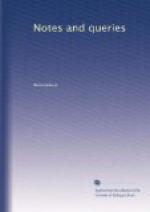Mathematicians seldom grow up solitarily in any locality. When one arises, the absence of all external and social incentives to the study can only betoken an inherent propensity and constitutional fitness for it. Such a man is too much in earnest to keep his knowledge to himself, or to wish to stand alone. He makes disciples,—he aids, encourages, guides them. His own researches are fully communicated; and this with a prodigality proportioned to his own great resources. He feels no jealousy of competition, and is always gratified by seeing others successful. Thus such bodies of men are created in wonderfully short periods by the magnanimous labours of one ardent {438} spirit. These are the men that found societies, schools, sects; wherever one unselfish and earnest man settles down, there we invariably find a cluster of students of his subject, that often lasts for ages. Take, for instance, Leeds. There we see that John Ryley created, at a later period, the Yorkshire school of geometers; comprising amongst its members such men as Swale, Whitley, Ryley ("Sam"), Gawthorp, Settle, and John Baines. This, too, was in a district in many respects very analogous to Lancashire, but especially in the one to which the argument more immediately relates:—it was a district of weavers, only substituting wool for cotton, as cotton had in the other case been substituted for the silk of Spitalfields.
We see nothing like this in the agricultural districts; neither do we in those districts where the ordinary manufacturing operations themselves require the employment of the head as well as the hands and feet. With the exception, indeed, of the schoolmaster, and the exciseman, and the surveyor, there are comparatively few instances of persons whose employment was not strictly sedentary having devoted their intellectual energies to mathematics, independent of early cultivation. To them the subject was more or less professional, and their devotion to it was to be expected—indeed far more than has been realised. It is professional now to a larger and more varied class of men, and of course there is a stronger body of non-academic mathematicians now than at any former period. At the same time it may be doubted whether there be even as many really able men devoted to science purely and for its own sake in this country as there were a century ago, when science wore a more humble guise.
Combining what is here said with the masterly analysis which MR. WILKINSON has given of the books which were accessible to these men, it appears that we shall be able to form a correct view on the subject of the Lancashire geometers. Of course documentary evidence would be desirable—it would certainly be interesting too.
To such of your readers as have not seen the mathematical periodicals of that period, the materials for which were furnished by these men, it may be sufficient to state that the “NOTES AND QUERIES” is conceived in the exact spirit of those works. The chief difference, besides the usual subject-matter, consists in the greater formality and “stiffness” of those than of this; arising, however, of necessity out of the specific and rigid character of mathematical research in itself, and the more limited range of subjects that were open to discussion.




